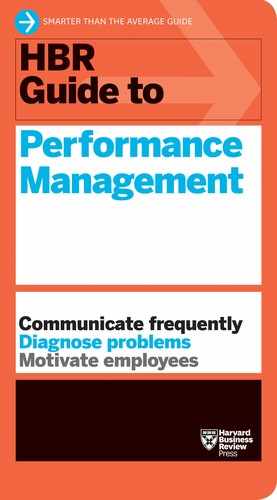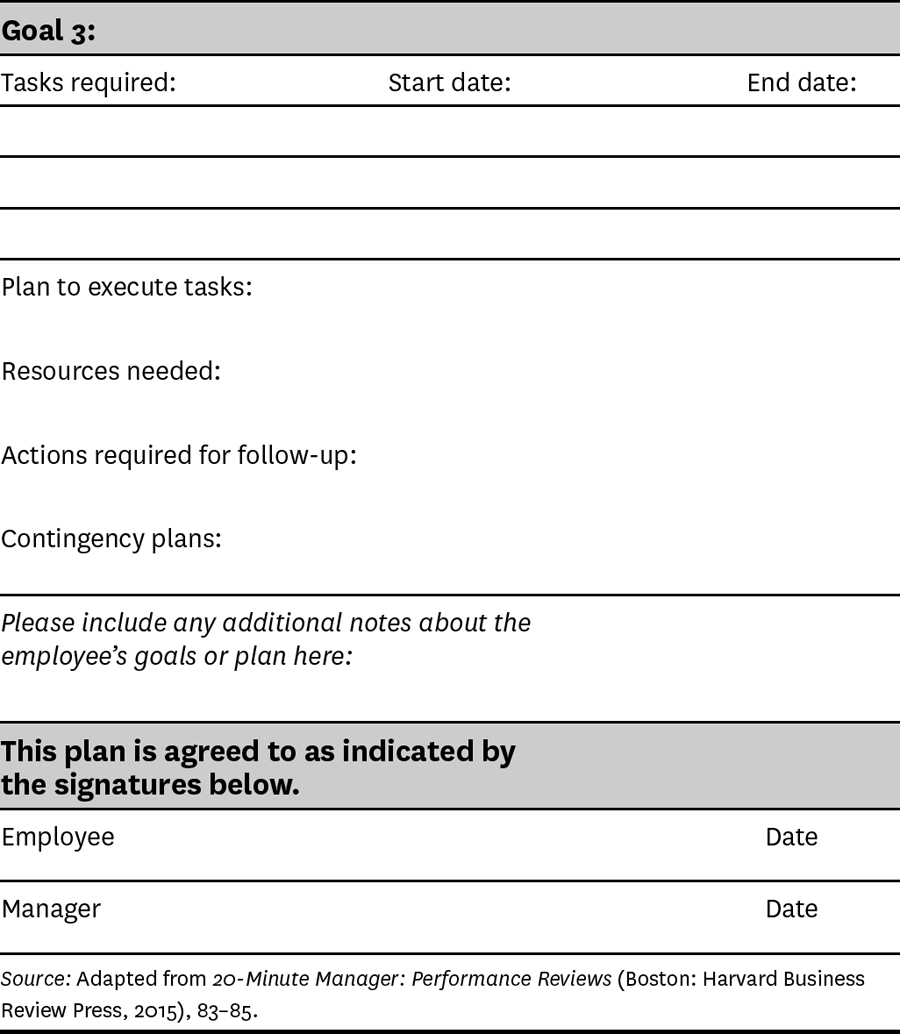CHAPTER 3
Collaborate with Your Employee to Create a Plan for Moving Forward
Once you and your employee have developed a clear set of challenging goals with specific metrics, you’ll need to ensure that there’s a practical plan in place for achieving them. As social psychologist Heidi Grant says, “Creating goals that teams and organizations will actually accomplish isn’t just a matter of defining what needs doing; you also have to spell out the specifics of getting it done, because you can’t assume that everyone involved will know how to move from concept to delivery.”1
Goals can seem impenetrable, even overwhelming, but they become much more manageable when there’s a detailed plan to reach them. An ambitious objective that will take a year to complete will be composed of many smaller parts and steps. For example, a financial services professional may set a goal of obtaining licensure for a certain specialty. It’s unlikely that he’ll be able to meet that goal simply by showing up for the licensure exam without any advance preparation. Instead, he’ll need to break the goal down into doable components, studying for each part of the exam over a predetermined period of time.
Your employees should do the same: When people create a plan to meet a goal, they are more likely to successfully achieve it. While some such plans may be straightforward and quick to pull together, others will be more difficult to figure out. But the time you invest at the beginning of the process will pay off when your employee nimbly works through what could have been tricky steps. Remember, too, that just as goals may shift over time, plans to achieve them may need to be adjusted.
Set a Comprehensive Plan for Success
In most cases you’ll want your employees to develop a plan for meeting goals that you can then review. The process of setting a plan can empower your direct report and create a sense of ownership. But in some cases, especially for challenging goals or with employees who are new to project planning, you may need to work together to complete the following steps.
Step 1: Determine the tasks needed to accomplish the goal
Break the goal down into task-based components. If one task seems overwhelming, separate it into smaller parts. Some items may be completed simultaneously (such as making tweaks to a draft marketing campaign while awaiting additional feedback), while others may need to be completed sequentially (such as getting approval for the final campaign before implementing it), so list them in the appropriate order. Determining each required task can make complex or long-term projects seem much more manageable.
Step 2: Plan the timing for each task
Set a start and finish date for each individual task, and describe the desired results or outcomes for each item. For team projects, you may be familiar with a Gantt chart or other time-scaled task diagram that illustrates an estimated schedule. A Gantt chart is an easy-to-read bar chart that clearly communicates what needs to be done in a particular time frame (see figure 3-1). The graphic shows you what tasks are upcoming and allows you to make adjustments in your plans as necessary, such as if one task takes longer than expected and subsequent ones need to be pushed forward.
Individuals can use a similar visual for their tasks by creating such a chart in an excel file or digital calendar. Mark intended milestones along the way, such as “We should have the first stage of task A completed by May 15.” With your employee, create an individualized diagram that includes each of their tasks. Watch out for overloading or tight time crunches, where if one task moves, deadlines may be missed. This tool can then be updated throughout the review period as schedules and goals shift.
As you develop the chart, think through contingency plans. If something does move, how should your employee adapt? Discuss such possibilities with your direct report, so they can stay on track even when the unexpected happens.
Step 3: Gather the resources needed to fulfill each task
Many efforts fail because people underestimate the time and resources required to accomplish each task. Once you’ve planned how each task will be executed and assigned its individual time line, consider what the employee will need to complete it. Do they have the bandwidth and equipment to manage these tasks in addition to their ongoing responsibilities? Does your direct report have the training and knowledge to be successful?
In some cases you may be able to supply the additional resources your employee requires—a new piece of technology, access to a database, or colleagues to assist them. But in others, you may discover that the person needs to learn new skills, particularly if they’re facing an especially challenging goal. When that’s the case, discuss ways you can help your employee fill the gaps. (See chapter 9, “Expand Your Employee’s Skill Sets,” to read more on how to develop these proficiencies.)
Step 4: Get it on paper
Once you and an employee have reached agreement on goals and created a detailed plan to reach them, document your conclusions. Your organization may have a form you can use, or you can create your own using the template in table 3-1 at the end of this chapter. Either way, you’ll want to include the following information:
- The date of your performance-planning meeting
- Key points brought up by both parties
- The employee’s goals for the next review period
- A detailed plan of what is required to achieve them
- A description of any resources or training you have agreed to provide
- A time frame for follow-up meetings
Some organizations require that statements of goals be submitted to HR, but whether yours does or not, keep the document on file for yourself, and share it with your employee as well. You’ll find this write-up helpful when it comes time to revise an employee’s goals, for evaluating their performance throughout the review period, and in the instance of a formal appraisal.
Follow Up and Reassess Goals
Performance management is an ongoing process, so regularly schedule check-in conversations to keep track of your direct reports’ progress toward both short- and long-term goals. If you don’t know how well someone is doing, you won’t know when to make adjustments in their plan to reach their objectives—or in the goals themselves. For example, GE encourages frequent conversations with employees to revisit two key questions: “What am I doing that I should keep doing? And what am I doing that I should change?”2
The timing of these check-ins can vary depending on how many employees you manage, how you work with your employees, or the general pace of your industry. In some instances your organization may have a particular recommendation. For instance, in their revamping of performance management practices, Deloitte implemented weekly check-ins. Some other companies suggest their managers check in monthly or quarterly.
You’re the best judge of how frequently you should meet with each of your direct reports. At the end of your performance-planning meeting, discuss with your employee when it makes sense to check in. Some meetings should be event-based: when an employee completes a task, reaches a milestone, or achieves a goal. But others will be between these points, simply to discuss ongoing progress. Set a schedule of check-ins in advance, and put your next meeting date on the calendar before you conclude the performance-planning session. These regular conversations are the most effective and time-efficient way to stay up-to-date on your employees’ performance.
When to change your employee’s goals
It’s possible that an employee may need to update their goals before the next performance appraisal comes around. Perhaps they’ve achieved a goal and need a new challenge, they’re taking over responsibilities for a teammate who’s shifted to a new role, or the organization’s objectives have changed. For instance, the goal of developing an innovative new app may need to adjust if the organization has decided to prioritize its current mobile interface instead.
If an employee’s goals need to be revised, meet to review previously set goals and plans. Three questions can guide you in your discussion as you reassess targets:
- Are they still realistic, given any changes in constraints or resources?
- Are they still timely? Is now the best possible moment to achieve them?
- Are they still relevant? Do they still align with the company’s strategy?
It may be necessary to change only a single goal by replacing it with a new one, but in cases of major change, the entire plan may need to shift. If, for example, your team has been diligently working toward a merger, everyone will need a new set of goals after the merger happens.
If you’re checking in with your direct reports on a regular basis about their progress, the need to change course or revise goals will come as no surprise. Additionally, every check-in will be another opportunity to monitor your employees’ performance, offer feedback, or provide coaching. These elements of ongoing performance management are the topic of the next section.
NOTES
1. Heidi Grant, “Get Your Team to Do What It Says It’s Going to Do,” Harvard Business Review, May 2014 (product #R1405E).
2. Peter Cappelli and Anna Tavis, “The Performance Management Revolution,” Harvard Business Review, October 2016 (product #R1610D).



